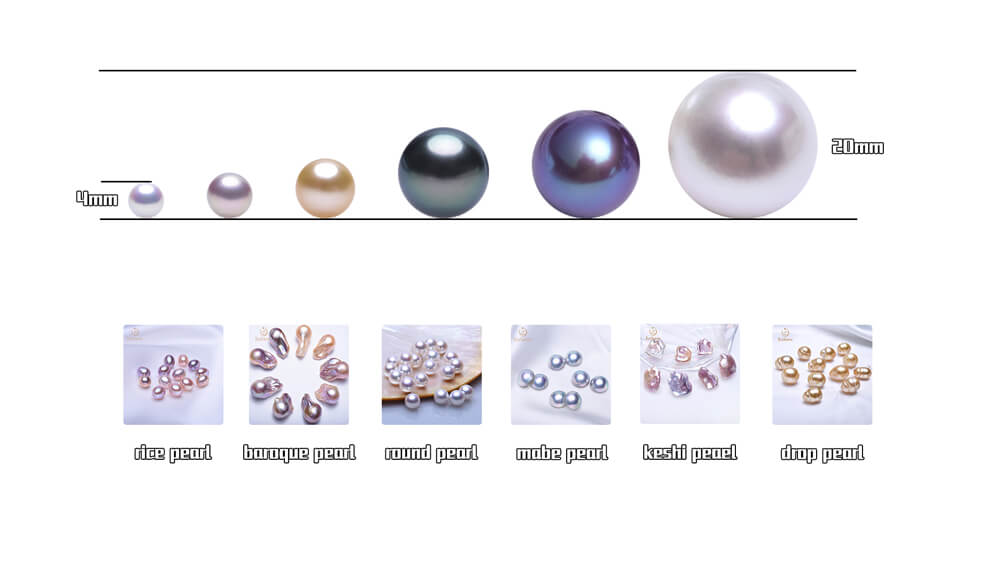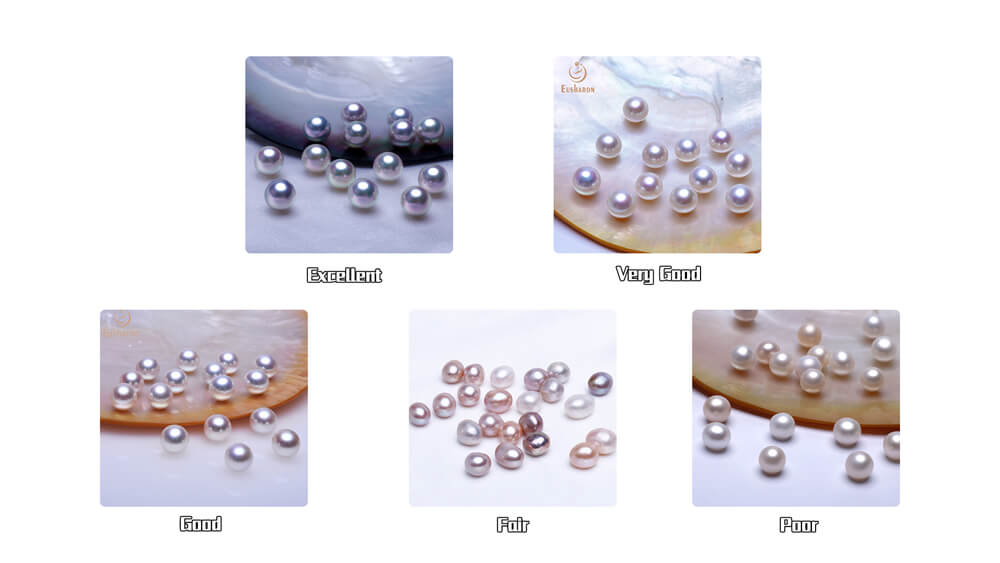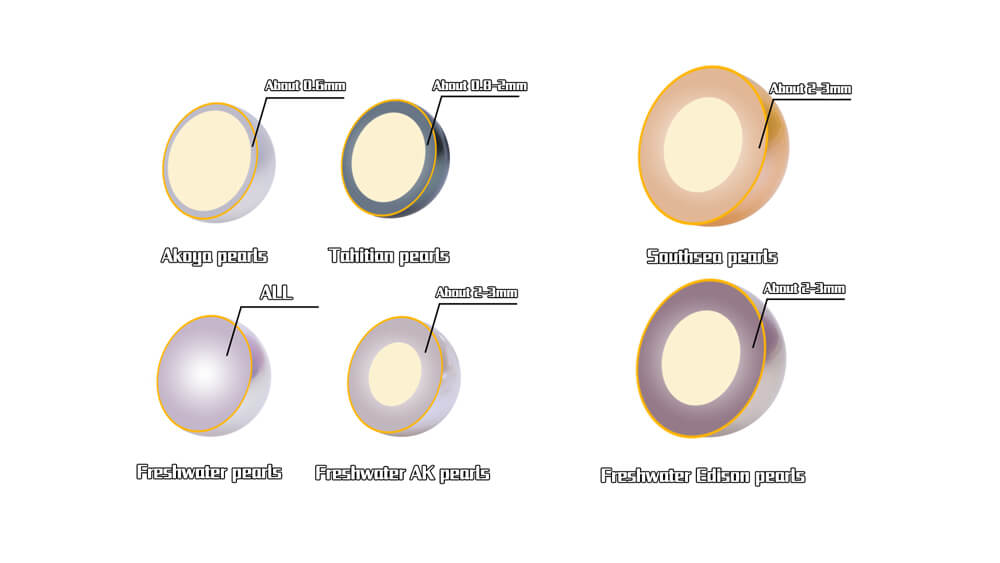In the pearl business, you often see a farmer, dealer, retailer, or experienced customer pick up a single pearl and examine it closely while slowly rotating it in the tips of the thumb, index, and middle fingers. Or you might see someone pick up a strand of pearls, hold a looped end with one hand and slowly draw the strand across the open palm of the other hand while closely examining the individual pearls.

These are the ways that pearl professionals judge the size and quality of a single pearl or of the pearls in a strand. Size and quality determine value. The characteristics used to assess the beauty and value of a pearl and contribute to a judgment of its quality are called value factors.
This article is based on the GIA pearl description system to help you grade pearls. It consists of seven value factors: size, shape, color, luster, surface, nacre thickness, and matching. The last factor, matching, doesn’t apply to single pearls or intentionally mismatched pearls. It measures the uniformity of appearance of 2 or more pearls that are intended to look alike.
-Size
Pearl measurements are stated in millimeters, rounded to the nearest 0.5 mm.
Generally the diameter of the spherical pearl is used as the measurement basis, and sometimes the length and width are measured to treat the special-shaped pearl.
A uniform stand is composed of pearls that are almost the same size and usually spherical. The error should not exceed 0.5mm. Some pearls stands are gradual, with the largest pearl in the center and gradually smaller pearls near the buckle.
Generally speaking, when other value factors within the pearl type are the same, the larger the pearl, the greater its value. Each pearl type has a size range, which includes most of the common sizes of that type.
For example, most spherical freshwater cultured pearls are between 4 and 15 mm in diameter. When other value factors are the same, larger freshwater pearls are more valuable than smaller freshwater pearls. However, you cannot compare the value of spherical freshwater pearls and spherical South Sea cultured pearls of the same size because they are of different types. At this time, the specific value needs to refer to other value factors.

-Color
The color of pearls generally depends on 3 characteristics:
Bodycolor—The dominant overall color of the pearl. This is still very obvious. Generally speaking, it is the color of the pearl itself. In addition to white pearls, the type of pearl can basically be determined by the color.
Overtone—a translucent colored halo that appears over a large area on the surface (surrounding) of a pearl.
Orient-there is more than one translucent color Overtone on the body color or surface.
All pearls have their own body color. It is mainly caused by natural pigments embedded in pearl clams. The Pigments vary depending on the species of mollusk and the individuals within each species. Other factors that help determine the color of pearls include the mantle used for pearl cultivation, substances in the water, and mollusk food.
Some pearls have overtone, which is a translucent color that appears outside the body color.
Overtone is always adjacent to the body color, if any is obvious.
On the whole pearl or most pearls, the most common halo colors are green, blue, and pink, depending on the body color of pearl.
Among pearls with a smooth surface and a regular shape, pearls with Orient are less than pearls with overtone, although both effects are caused by the same complex interaction of nacre and light. The orient area is smaller and more colorful than the overtone, and it is most common in non-spherical pearls with irregular surfaces. The Orient color on the surface which can be composed several colors of rainbow.
Pearls Color Term:
Apricot—Light pinkish orange Chinese freshwater cultured pearls
Aubergine—Tahitian cultured pearls with dark grayish purple bodycolor; sometimes called “cherry”
Golden—Strong greenish yellow to orangy yellow South Sea cultured pearls
Lavender—Light pinkish purple Chinese freshwater cultured pearls
Peacock—Tahitian cultured pearls with a dark green-gray to blue-gray bodycolor and pink to purple overtones
Pistachio—Tahitian cultured pearls with a yellowish green to greenish yellow bodycolor
-Luster
Of all the value factors, luster might be the most important. It’s the special feature that sets pearls apart from other gems.
As you’ve read, luster is the intensity and sharpness of the light reflected from a pearl’s surface. Nacreous pearls display varying degrees of luster, while non-nacreous pearls have a softer shine.
Thick nacre isn’t necessarily high-quality nacre. But it has to be thick enough and have enough layers to interact with light. The necessary thickness varies because it’s influenced by the other factors.
The quality of the nacre is mainly determined by its density, the greater the density, the stronger the luster.
Eusharon divides pearl luster into the following grades based on industry experience
Aurora—Reflections appear bright and sharp with overtone
Excellent—Reflections appear bright and sharp
Very Good—Reflections appear bright and near sharp
Good—Reflections are bright but not sharp
Fair—Reflections are weak and blurred
Poor—Reflections are dim and diffused

-Surface
Few pearls are completely blemish-free. When other value factors are equal, the fewer visible blemishes there are on a pearl’s surface, the higher its value.
Based on the GIA standard, Eusharon's own assessment of the pearl surface grade is as follows.
Flawless/Clean— Blemish-free or contain tiny surface characteristics
Lightly spotted—Pearls show minor surface irregularities
Moderately spotted—Pearls show noticeable surface characteristics.
Heavily spotted—Pearls show obvious surface irregularities. Durability might be affected.
-Nacre Quality
Nacre quality is determined by its thickness and the regularity.
Generally speaking, the thickness of South Sea pearls is about 2-3mm, Tahitian pearls are about 0.8-2mm, and Akoya pearls are about 0.3-0.6m. Non- nucleated freshwater pearls are all nacres, nucleated pearls and South Sea cultured pearls. The thickness of the bead layer is similar, about 2mm.

-Matching
Matching applies when two or more pearls are sorted for uniformity and used in a strand or other jewelry item.
Designers often intentionally mismatch pearls in bracelets, strands, other necklaces, and even earrings. Jewelry with deliberately mismatched pearls often has an eclectic, casual look. The items can still be very attractive, with the design achieving a pleasing visual harmony.
→What about Pearl Quality Factor-Pearl Matching?
→Click to find Ultimate Guide to Pearls-Grading Standards and Quality Control
Data verity from GIA and Wikipedia


















